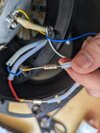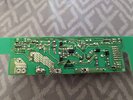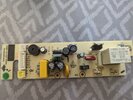amateur_24
Member
Hi
I am trying to fix an air fryer that doesn't turn on.
I have discovered there isn't any ac power coming into the main board but there is ac power on the mains flex connection.
I traced backwards from where the ac is connected to the board. I found the board to be wired in series with a device shown in the picture. There are two one in series
What is this device called and how do I test it?
I suspect it's failed because that the only point of failure I can find.
I am trying to fix an air fryer that doesn't turn on.
I have discovered there isn't any ac power coming into the main board but there is ac power on the mains flex connection.
I traced backwards from where the ac is connected to the board. I found the board to be wired in series with a device shown in the picture. There are two one in series
What is this device called and how do I test it?
I suspect it's failed because that the only point of failure I can find.



